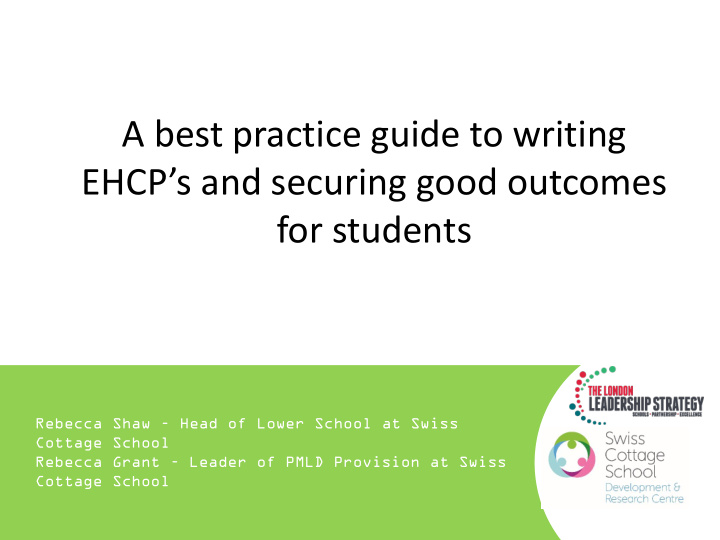



A best practice guide to writing EHCP’s and securing good outcomes for students Rebecca Shaw – Head of Lower School at Swiss Cottage School Rebecca Grant – Leader of PMLD Provision at Swiss Cottage School
Our vision for children with special educational needs and disabilities is the same as for all children and young people – that they achieve well in their early years, at school and in college, and lead happy and fulfilled lives. Dr Poulter, Parliamentary Under-Secretary of State for Health Edward Timpson, Parliamentary Under-Secretary of State for Children and Families
Aims of this presentation: • To explore what a good EHCP could look like and how it can be constructed. • To look at what needs to be in place in order to meet the needs of all pupils .
National Context Mainstream Mainstream Specialist Total In Primary Secondary Settings England Number of Pupils 8,438,145 Pupils Identified 1,065,280 634,105 396,035 with SEN without Statements/EHCP Pupils Identified 236,165 62,235 58,100 115,830 with SEN with Statements/EHCP (SFR 2015)
SEND Code of Practice Transition to Legislation Changes (pg35)
A good EHCP: Positive account of what the learner can do as well as identifying what needs to happen. Clear, concise, understandable and accessible. Meets the requirements of the Code of Practice. (Assessments and Education Health and Care Plans: DoE 2014)
Section A: Pupil Voice Parent View Their journey Personal Profile
Section B: Cognition and Learning Sam needs short bursts of learning with the support of checklists Needs and timers followed by small breaks. Sam is able to participate in learning which he finds interesting Strengths and is motivated to finish the activity.
Section C and D: Needs glasses Has very due to supportive significant engaged visual family. impairment A person who is new could clearly identify health Strengths Needs and social care priorities for the learner Adaptations to home for safe No allergies manual handling
Section E: Section E – Outcomes Outcomes identified Aspirations and goals for the future e.g. the sort of person I would like to be and what I would Outcomes to be met by the end of the key stage or phase like to do in the future. of education Long-term goals might include: health and wellbeing; By date: July 2016 friendships and relationships; community inclusion; education and employment; independent living. (Link with Section A ) To develop communicative independence across a range of To be able to live independently familiar settings e.g. to order food, to buy a bus ticket. To be able to get dressed independently every day. To be able to prepare and cook a simple meal. What are the intermediate Refer back to Section A – steps toward the future and What do we want for this when do we expect these to child at 25? be achieved?
“The needs of the individual child or young person should sit at the heart of the assessment and planning process. LAs must have regard to the views, wishes and feelings of the What do you do? child and their parent or the young person, their aspirations, the outcomes they wish to seek and the support they need to achieve them.” (Para 9.22 Code of Practice)
Section F: • What does the learner need? Refer back to Section B . Needs • What has the team agreed the outcomes should be for this learner? Refer back to Section E . Outcomes • What do we need to put in place in order for the outcomes to be achieved and the needs be met? Provision
Section F: • What do we need to put in place in order for the Provision outcomes to be achieved and the needs be met? • All provision that is required to meet the learners SEN must be specified. • All provision listed must state who is responsible for delivery and how often it will happen. • It must be clear, concise and leave no room for doubt. • Has all relevant information from the previous statement been transferred over?
Example: (Assessments and Education Health and Care Plans: DoE 2014)
Systemic Solutions Leadership Efficient use of resources Monitoring, tracking and evaluation Assessment and identification Working with pupils and parents http://www.thesendreview.co m/review-guide Improving teaching and learning Developing provision Improving outcomes
Individual School Locality Potential Focus on self-evaluation, supported by a peer SEND Legislation solution Practitioner-led process, develop through collaboration Build Locality/Regional capacity Strengthen provision Common language and Grow capacity across the knowledge of the 8 areas system School-led process 16
Recommend
More recommend